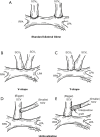Bilateral bidirectional cavopulmonary connection: a review of surgical techniques and clinical implications
- PMID: 38840681
- PMCID: PMC11148731
- DOI: 10.21037/tp-24-28
Bilateral bidirectional cavopulmonary connection: a review of surgical techniques and clinical implications
Abstract
The presence of bilateral superior caval veins (bSCVs) could negatively influence the outcome of Fontan patients. In the setting of a bilateral bidirectional Glenn, the selective blood flow to the ipsilateral long with consequent flow stagnation in the connecting portion could lead to poor growth of the central portion of the pulmonary artery, potentially affecting the eligibility for Fontan completion and being associated with a higher incidence of thrombotic complications. Alternative surgical techniques have been described to perform a bidirectional cavopulmonary anastomosis in the presence of bSCVs aiming to achieve a balanced growth of the pulmonary bifurcation. The short-term results of these techniques such as the V- or Y-shape seem to be excellent; however, some anatomical settings could affect the feasibility of these techniques. The so-called "unifocalization" creates a configuration comparable to a "normal" bidirectional Glenn and could be a feasible alternative. However, the long-term results of this technique are not published yet. The positive effect of additional pulsatile pulmonary flow on pulmonary artery growth should be considered in case of bilateral bidirectional Glenn, despite the higher incidence of postoperative complications reported and the difficult calibration of the amount of additional flow. The role of computational fluid dynamic to simulate the surgical strategy in single ventricle patients is promising and could be worthwhile in the setting of bSCVs. In fact, the surgical techniques of bilateral bidirectional Glenn could be simulated testing their feasibility and allowing to identify the more favorable hemodynamic pattern, patient specific. This review article highlights the critical issues related to the presence of bSCVs in univentricular physiology, analyzing pros and cons of the different surgical techniques. Besides reviewing the literature, this manuscript focuses on the role of computational fluid simulation in identifying the most favorable surgical technique with an individualized approach, which could potentially improve the clinical outcome.
Keywords: Bilateral bidirectional Glenn; bilateral superior caval veins (bSCVs); cavopulmonary connection; computational fluid dynamics simulations.
2024 Translational Pediatrics. All rights reserved.
Conflict of interest statement
Conflicts of Interest: Both authors have completed the ICMJE uniform disclosure form (available at https://tp.amegroups.com/article/view/10.21037/tp-24-28/coif). The column “Pediatric Heart” was commissioned by the editorial office without any funding or sponsorship. The authors have no other conflicts of interest to declare.
Figures

References
Publication types
LinkOut - more resources
Full Text Sources
Miscellaneous
